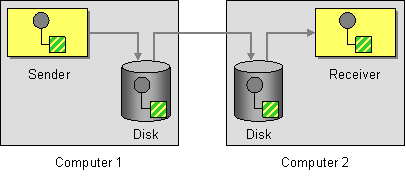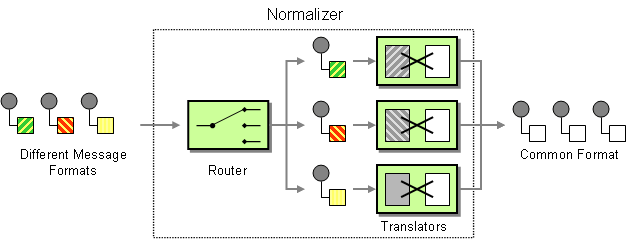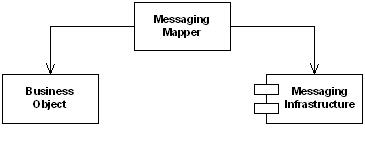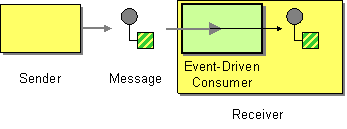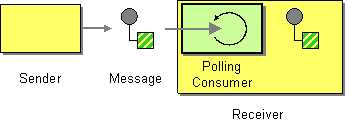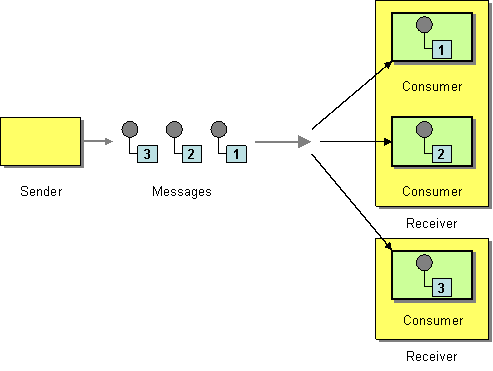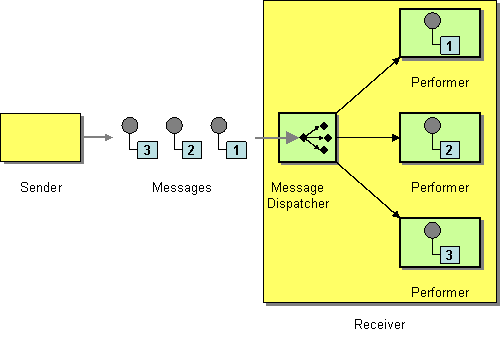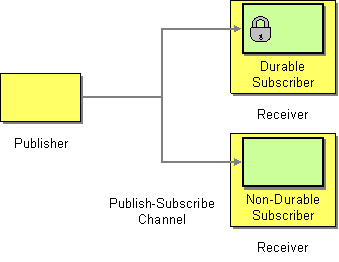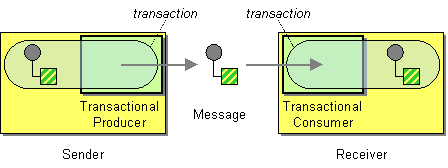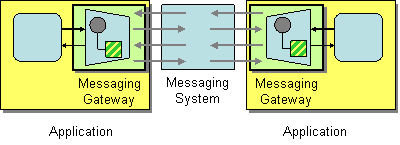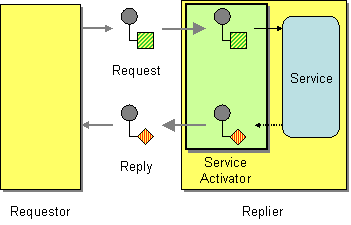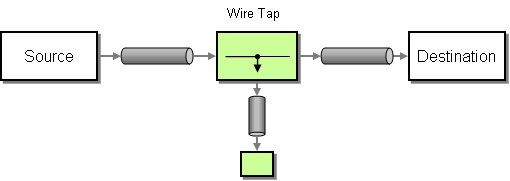Enterprise Integration Patterns
Camel supports most of the Enterprise Integration Patterns from the excellent book of the same name by Gregor Hohpe and Bobby Woolf. Its a highly recommended book, particularly for users of Camel.
There now follows a list of the Enterprise Integration Patterns from the book along with examples of the various patterns using Apache Camel
Messaging Systems
How does one application communicate with another using messaging? | ||
How can two applications connected by a message channel exchange a piece of information? | ||
How can we perform complex processing on a message while maintaining independence and flexibility? | ||
How can you decouple individual processing steps so that messages can be passed to different filters depending on a set of conditions? | ||
How can systems using different data formats communicate with each other using messaging? | ||
How does an application connect to a messaging channel to send and receive messages? |
Messaging Channels
How can the caller be sure that exactly one receiver will receive the document or perform the call? | ||
How can the sender broadcast an event to all interested receivers? | ||
What will the messaging system do with a message it cannot deliver? | ||
How can the sender make sure that a message will be delivered, even if the messaging system fails? | ||
What is an architecture that enables separate applications to work together, but in a de-coupled fashion such that applications can be easily added or removed without affecting the others? |
Message Construction
How can messaging be used to transmit events from one application to another? | ||
When an application sends a message, how can it get a response from the receiver? | ||
How does a requestor that has received a reply know which request this is the reply for? | ||
How does a replier know where to send the reply? |
Message Routing
How do we handle a situation where the implementation of a single logical function (e.g., inventory check) is spread across multiple physical systems? | ||
How can a component avoid receiving uninteresting messages? | ||
How can you avoid the dependency of the router on all possible destinations while maintaining its efficiency? | ||
How do we route a message to a list of (static or dynamically) specified recipients? | ||
How can we process a message if it contains multiple elements, each of which may have to be processed in a different way? | ||
How do we combine the results of individual, but related messages so that they can be processed as a whole? | ||
How can we get a stream of related but out-of-sequence messages back into the correct order? | ||
How can you maintain the overall message flow when processing a message consisting of multiple elements, each of which may require different processing? | ||
How do you maintain the overall message flow when a message needs to be sent to multiple recipients, each of which may send a reply? | ||
How do we route a message consecutively through a series of processing steps when the sequence of steps is not known at design-time and may vary for each message? | ||
How can I throttle messages to ensure that a specific endpoint does not get overloaded, or we don't exceed an agreed SLA with some external service? | ||
How can I sample one message out of many in a given period to avoid downstream route does not get overloaded? | ||
How can I delay the sending of a message? | ||
How can I balance load across a number of endpoints? | ||
To use Hystrix Circuit Breaker when calling an external service. | ||
To call a remote service in a distributed system where the service is looked up from a service registry of some sorts. | ||
How can I route a message to a number of endpoints at the same time? | ||
How can I repeat processing a message in a loop? |
Message Transformation
How do we communicate with another system if the message originator does not have all the required data items available? | ||
How do you simplify dealing with a large message, when you are interested only in a few data items? | ||
How can we reduce the data volume of message sent across the system without sacrificing information content? | ||
How do you process messages that are semantically equivalent, but arrive in a different format? | ||
How can I sort the body of a message? | ||
Script | How do I execute a script which may not change the message? | |
How can I validate a message? |
Messaging Endpoints
How do you move data between domain objects and the messaging infrastructure while keeping the two independent of each other? | ||
How can an application automatically consume messages as they become available? | ||
How can an application consume a message when the application is ready? | ||
How can a messaging client process multiple messages concurrently? | ||
How can multiple consumers on a single channel coordinate their message processing? | ||
How can a message consumer select which messages it wishes to receive? | ||
How can a subscriber avoid missing messages while it's not listening for them? | ||
How can a message receiver deal with duplicate messages? | ||
How can a client control its transactions with the messaging system? | ||
How do you encapsulate access to the messaging system from the rest of the application? | ||
How can an application design a service to be invoked both via various messaging technologies and via non-messaging techniques? |
System Management
How can we effectively administer a messaging system that is distributed across multiple platforms and a wide geographic area? | ||
How can you route a message through intermediate steps to perform validation, testing or debugging functions? | ||
How do you inspect messages that travel on a point-to-point channel? | ||
How can we effectively analyze and debug the flow of messages in a loosely coupled system? | ||
How can I log processing a message? |
Messaging Systems
Message
Camel supports the Message from the EIP patterns using the Message interface.
To support various message exchange patterns like one way Event Message and Request Reply messages Camel uses an Exchange interface which has a pattern property which can be set to InOnly for an Event Message which has a single inbound Message, or InOut for a Request Reply where there is an inbound and outbound message.
Here is a basic example of sending a Message to a route in InOnly and InOut modes
Requestor Code
//InOnly
getContext().createProducerTemplate().sendBody("direct:startInOnly", "Hello World");
//InOut
String result = (String) getContext().createProducerTemplate().requestBody("direct:startInOut", "Hello World");
Route Using the Fluent Builders
from("direct:startInOnly").inOnly("bean:process");
from("direct:startInOut").inOut("bean:process");
Route Using the Spring XML Extensions
<route> <from uri="direct:startInOnly"/> <inOnly uri="bean:process"/> </route> <route> <from uri="direct:startInOut"/> <inOut uri="bean:process"/> </route>
Using This Pattern
If you would like to use this EIP Pattern then please read the Getting Started, you may also find the Architecture useful particularly the description of Endpoint and URIs. Then you could try out some of the Examples first before trying this pattern out.
Pipes and Filters
Camel supports the Pipes and Filters from the EIP patterns in various ways.
With Camel you can split your processing across multiple independent Endpoint instances which can then be chained together.
Using Routing Logic
You can create pipelines of logic using multiple Endpoint or Message Translator instances as follows
In Spring XML you can use the <pipeline/> element
In the above the pipeline element is actually unnecessary, you could use this:
which is a bit more explicit.
However if you wish to use <multicast/> to avoid a pipeline - to send the same message into multiple pipelines - then the <pipeline/> element comes into its own:
In the above example we are routing from a single Endpoint to a list of different endpoints specified using URIs. If you find the above a bit confusing, try reading about the Architecture or try the Examples
Message Translator
Camel supports the Message Translator from the EIP patterns by using an arbitrary Processor in the routing logic, by using a bean to perform the transformation, or by using transform() in the DSL. You can also use a Data Format to marshal and unmarshal messages in different encodings.
Using the Fluent Builders
You can transform a message using Camel's Bean Integration to call any method on a bean in your Registry such as your Spring XML configuration file as follows
Where the "myTransformerBean" would be defined in a Spring XML file or defined in JNDI etc. You can omit the method name parameter from beanRef() and the Bean Integration will try to deduce the method to invoke from the message exchange.
or you can add your own explicit Processor to do the transformation
or you can use the DSL to explicitly configure the transformation
Use Spring XML
You can also use Spring XML Extensions to do a transformation. Basically any Expression language can be substituted inside the transform element as shown below
Or you can use the Bean Integration to invoke a bean
You can also use Templating to consume a message from one destination, transform it with something like Velocity or XQuery and then send it on to another destination. For example using InOnly (one way messaging)
If you want to use InOut (request-reply) semantics to process requests on the My.Queue queue on ActiveMQ with a template generated response, then sending responses back to the JMSReplyTo Destination you could use this.
Message Endpoint
Camel supports the Message Endpoint from the EIP patterns using the Endpoint interface.
When using the DSL to create Routes you typically refer to Message Endpoints by their URIs rather than directly using the Endpoint interface. Its then a responsibility of the CamelContext to create and activate the necessary Endpoint instances using the available Component implementations.
Example
The following example route demonstrates the use of a File Consumer Endpoint and JMS Producer Endpoint
Using the Fluent Builders
from("file://local/router/messages/foo")
.to("jms:queue:foo");
Using the Spring XML Extensions
<route> <from uri="file://local/router/messages/foo"/> <to uri="jms:queue:foo"/> </route>
Dynamic To
Available as of Camel 2.16
There is a new <toD> that allows to send a message to a dynamic computed Endpoint using one or more Expression that are concat together. By default the Simple language is used to compute the endpoint. For example to send a message to a endpoint defined by a header you can do
<route>
<from uri="direct:start"/>
<toD uri="${header.foo}"/>
</route>
And in Java DSL
from("direct:start")
.toD("${header.foo}");
You can also prefix the uri with a value because by default the uri is evaluated using the Simple language
<route>
<from uri="direct:start"/>
<toD uri="mock:${header.foo}"/>
</route>
And in Java DSL
from("direct:start")
.toD("mock:${header.foo}");
In the example above we compute an endpoint that has prefix "mock:" and then the header foo is appended. So for example if the header foo has value order, then the endpoint is computed as "mock:order".
You can also use other languages than Simple such as XPath - this requires to prefix with language: as shown below (simple language is the default language). If you do not specify language: then the endpoint is a component name. And in some cases there is both a component and language with the same name such as xquery.
<route> <from uri="direct:start"/> <toD uri="language:xpath:/order/@uri"/> </route>
This is done by specifying the name of the language followed by a colon.
from("direct:start")
.toD("language:xpath:/order/@uri");
You can also concat multiple Language(s) together using the plus sign + such as shown below:
<route>
<from uri="direct:start"/>
<toD uri="jms:${header.base}+language:xpath:/order/@id"/>
</route>
In the example above the uri is a combination of Simple language and XPath where the first part is simple (simple is default language). And then the plus sign separate to another language, where we specify the language name followed by a colon
from("direct:start")
.toD("jms:${header.base}+language:xpath:/order/@id");
You can concat as many languages as you want, just separate them with the plus sign
The Dynamic To has a few options you can configure
| Name | Default Value | Description |
|---|---|---|
| uri | Mandatory: The uri to use. See above | |
| pattern | To set a specific Exchange Pattern to use when sending to the endpoint. The original MEP is restored afterwards. | |
| cacheSize | Allows to configure the cache size for the ProducerCache which caches producers for reuse. Will by default use the default cache size which is 1000. Setting the value to -1 allows to turn off the cache all together. | |
| ignoreInvalidEndpoint | false | Whether to ignore an endpoint URI that could not be resolved. If disabled, Camel will throw an exception identifying the invalid endpoint URI. |
For more details see
Using This Pattern
If you would like to use this EIP Pattern then please read the Getting Started, you may also find the Architecture useful particularly the description of Endpoint and URIs. Then you could try out some of the Examples first before trying this pattern out.
Messaging Channels
Guaranteed Delivery
Camel supports the Guaranteed Delivery from the EIP patterns using among others the following components:
- File for using file systems as a persistent store of messages
- JMS when using persistent delivery (the default) for working with JMS Queues and Topics for high performance, clustering and load balancing
- JPA for using a database as a persistence layer, or use any of the many other database component such as SQL, JDBC, iBATIS/MyBatis, Hibernate
- HawtDB for a lightweight key-value persistent store
Example
The following example demonstrates illustrates the use of Guaranteed Delivery within the JMS component. By default, a message is not considered successfully delivered until the recipient has persisted the message locally guaranteeing its receipt in the event the destination becomes unavailable.
Using the Fluent Builders
from("direct:start")
.to("jms:queue:foo");
Using the Spring XML Extensions
<route> <from uri="direct:start"/> <to uri="jms:queue:foo"/> </route>
Using This Pattern
If you would like to use this EIP Pattern then please read the Getting Started, you may also find the Architecture useful particularly the description of Endpoint and URIs. Then you could try out some of the Examples first before trying this pattern out.
Message Routing
Content Based Router
The Content Based Router from the EIP patterns allows you to route messages to the correct destination based on the contents of the message exchanges.
The following example shows how to route a request from an input seda:a endpoint to either seda:b, seda:c or seda:d depending on the evaluation of various Predicate expressions
Using the Fluent Builders
RouteBuilder builder = new RouteBuilder() {
public void configure() {
errorHandler(deadLetterChannel("mock:error"));
from("direct:a")
.choice()
.when(header("foo").isEqualTo("bar"))
.to("direct:b")
.when(header("foo").isEqualTo("cheese"))
.to("direct:c")
.otherwise()
.to("direct:d");
}
};
See Why can I not use when or otherwise in a Java Camel route if you have problems with the Java DSL, accepting using when or otherwise.
Using the Spring XML Extensions
<camelContext errorHandlerRef="errorHandler" xmlns="http://camel.apache.org/schema/spring">
<route>
<from uri="direct:a"/>
<choice>
<when>
<xpath>$foo = 'bar'</xpath>
<to uri="direct:b"/>
</when>
<when>
<xpath>$foo = 'cheese'</xpath>
<to uri="direct:c"/>
</when>
<otherwise>
<to uri="direct:d"/>
</otherwise>
</choice>
</route>
</camelContext>
For further examples of this pattern in use you could look at the junit test case
Using This Pattern
If you would like to use this EIP Pattern then please read the Getting Started, you may also find the Architecture useful particularly the description of Endpoint and URIs. Then you could try out some of the Examples first before trying this pattern out.
Message Filter
The Message Filter from the EIP patterns allows you to filter messages
The following example shows how to create a Message Filter route consuming messages from an endpoint called queue:a, which if the Predicate is true will be dispatched to queue:b
Using the Fluent Builders
Using the Spring XML Extensions
Ensure you put the endpoint you want to filter <to uri="seda:b"/> before the closing </filter> tag or the filter will not be applied. From Camel 2.8: omitting this will result in an error.
For further examples of this pattern in use you could look at the junit test case
Using stop()
Stop is a bit different than a message filter as it will filter out all messages and end the route entirely (filter only applies to its child processor). Stop is convenient to use in a Content Based Router when you for example need to stop further processing in one of the predicates.
In the example below we do not want to route messages any further that has the word Bye in the message body. Notice how we prevent this in the when() predicate by using the .stop().
How To Determine If An Exchange Was Filtered
Available as of Camel 2.5
The Message Filter EIP will add a property on the Exchange that states if it was filtered or not.
The property has the key Exchange.FILTER_MATCHED, which has the String value of CamelFilterMatched. Its value is a boolean indicating true or false. If the value is true then the Exchange was routed in the filter block. This property will be visible within the Message Filter block who's Predicate matches (value set to true), and to the steps immediately following the Message Filter with the value set based on the results of the last Message Filter Predicate evaluated.
Message Transformation
Normalizer
Camel supports the Normalizer from the EIP patterns by using a Message Router in front of a number of Message Translator instances.
Example
This example shows a Message Normalizer that converts two types of XML messages into a common format. Messages in this common format are then filtered.
Using the Fluent Builders
In this case we're using a Java bean as the normalizer. The class looks like this
Using the Spring XML Extensions
The same example in the Spring DSL
See Also
Messaging Endpoints
Messaging Mapper
Camel supports the Messaging Mapper from the EIP patterns by using either Message Translator pattern or the Type Converter module.
Example
The following example demonstrates the use of a Bean component to map between two messaging system
Using the Fluent Builders
from("activemq:foo")
.beanRef("transformerBean", "transform")
.to("jms:bar");
Using the Spring XML Extensions
<route> <from uri="activemq:foo"/> <bean ref="transformerBean" method="transform" /> <to uri="jms:bar"/> </route>
See also
- Message Translator
- Type Converter
- CXF for JAX-WS support for binding business logic to messaging & web services
- Pojo
- Bean
Using This Pattern
If you would like to use this EIP Pattern then please read the Getting Started, you may also find the Architecture useful particularly the description of Endpoint and URIs. Then you could try out some of the Examples first before trying this pattern out.
Event Driven Consumer
Camel supports the Event Driven Consumer from the EIP patterns. The default consumer model is event based (i.e. asynchronous) as this means that the Camel container can then manage pooling, threading and concurrency for you in a declarative manner.
The Event Driven Consumer is implemented by consumers implementing the Processor interface which is invoked by the Message Endpoint when a Message is available for processing.
Example
The following demonstrates a Processor defined in the Camel Registry which is invoked when an event occurs from a JMS queue
Using the Fluent Builders
from("jms:queue:foo")
.processRef("processor");
Using the Spring XML Extensions
<route> <from uri="jms:queue:foo"/> <to uri="processor"/> </route>
For more details see
Using This Pattern
If you would like to use this EIP Pattern then please read the Getting Started, you may also find the Architecture useful particularly the description of Endpoint and URIs. Then you could try out some of the Examples first before trying this pattern out.
Polling Consumer
Camel supports implementing the Polling Consumer from the EIP patterns using the PollingConsumer interface which can be created via the Endpoint.createPollingConsumer() method.
In Java:
The ConsumerTemplate (discussed below) is also available.
There are three main polling methods on PollingConsumer
Method name | Description |
|---|---|
Waits until a message is available and then returns it; potentially blocking forever | |
Attempts to receive a message exchange, waiting up to the given timeout and returning null if no message exchange could be received within the time available | |
Attempts to receive a message exchange immediately without waiting and returning null if a message exchange is not available yet |
EventDrivenPollingConsumer Options
The EventDrivePollingConsumer (the default implementation) supports the following options:
Option | Default | Description |
|---|---|---|
|
| Camel 2.14/2.13.1/2.12.4: The queue size for the internal hand-off queue between the polling consumer, and producers sending data into the queue. |
|
| Camel 2.14/2.13.1/2.12/4: Whether to block any producer if the internal queue is full. |
pollingConsumerBlockTimeout | 0 | Camel 2.16: To use a timeout (in milliseconds) when the producer is blocked if the internal queue is full. If the value is 0 or negative then no timeout is in use. If a timeout is triggered then a ExchangeTimedOutException is thrown. |
Notice that some Camel Components has their own implementation of PollingConsumer and therefore do not support the options above.
You can configure these options in endpoints URIs, such as shown below:
ConsumerTemplate
The ConsumerTemplate is a template much like Spring's JmsTemplate or JdbcTemplate supporting the Polling Consumer EIP. With the template you can consume Exchanges from an Endpoint. The template supports the three operations listed above. However, it also includes convenient methods for returning the body, etc consumeBody.
Example:
Or to extract and get the body you can do:
And you can provide the body type as a parameter and have it returned as the type:
You get hold of a ConsumerTemplate from the CamelContext with the createConsumerTemplate operation:
Using ConsumerTemplate with Spring DSL
With the Spring DSL we can declare the consumer in the CamelContext with the consumerTemplate tag, just like the ProducerTemplate. The example below illustrates this:ConsumerTemplate in our java class. The code below is part of an unit test but it shows how the consumer and producer can work together.
Timer Based Polling Consumer
In this sample we use a Timer to schedule a route to be started every 5th second and invoke our bean MyCoolBean where we implement the business logic for the Polling Consumer. Here we want to consume all messages from a JMS queue, process the message and send them to the next queue.
First we setup our route as:
Scheduled Poll Components
Quite a few inbound Camel endpoints use a scheduled poll pattern to receive messages and push them through the Camel processing routes. That is to say externally from the client the endpoint appears to use an Event Driven Consumer but internally a scheduled poll is used to monitor some kind of state or resource and then fire message exchanges.
Since this a such a common pattern, polling components can extend the ScheduledPollConsumer base class which makes it simpler to implement this pattern. There is also the Quartz Component which provides scheduled delivery of messages using the Quartz enterprise scheduler.
For more details see:
- PollingConsumer
- Scheduled Polling Components
ScheduledPollConsumer Options
The ScheduledPollConsumer supports the following options:
Option | Default | Description |
|---|---|---|
|
| Camel 2.12: The number of subsequent error polls (failed due some error) that should happen before the |
|
| Camel 2.12: The number of subsequent idle polls that should happen before the |
|
| Camel 2.12: To let the scheduled polling consumer back-off if there has been a number of subsequent idles/errors in a row. The multiplier is then the number of polls that will be skipped before the next actual attempt is happening again. When this option is in use then |
|
| Milliseconds before the next poll. |
|
| Camel 2.10.6/2.11.1: If greedy is enabled, then the |
|
| Milliseconds before the first poll starts. |
| A pluggable The default implementation will log the caused exception at | |
|
| Camel 2.8: The consumer logs a start/complete log line when it polls. This option allows you to configure the logging level for that. |
|
| Camel 2.10: Allows for configuring a custom/shared thread pool to use for the consumer. By default each consumer has its own single threaded thread pool. This option allows you to share a thread pool among multiple consumers. |
|
| Camel 2.12: Allow to plugin a custom See Quartz2 page for an example. |
|
| Camel 2.12: To configure additional properties when using a custom |
|
| Camel 2.9: If the polling consumer did not poll any files, you can enable this option to send an empty message (no body) instead. |
|
| Whether the scheduler should be auto started. |
|
| Time unit for |
|
| Controls if fixed delay or fixed rate is used. See ScheduledExecutorService in JDK for details. In Camel 2.7.x or older the default value is From Camel 2.8: the default value is |
Using backoff to Let the Scheduler be Less Aggressive
Available as of Camel 2.12
The scheduled Polling Consumer is by default static by using the same poll frequency whether or not there is messages to pickup or not.
From Camel 2.12: you can configure the scheduled Polling Consumer to be more dynamic by using backoff. This allows the scheduler to skip N number of polls when it becomes idle, or there has been X number of errors in a row. See more details in the table above for the backoffXXX options.
For example to let a FTP consumer back-off if its becoming idle for a while you can do:
In this example, the FTP consumer will poll for new FTP files every 5th second. But if it has been idle for 5 attempts in a row, then it will back-off using a multiplier of 6, which means it will now poll every 5 x 6 = 30th second instead. When the consumer eventually pickup a file, then the back-off will reset, and the consumer will go back and poll every 5th second again.
Camel will log at DEBUG level using org.apache.camel.impl.ScheduledPollConsumer when back-off is kicking-in.
About Error Handling and Scheduled Polling Consumers
ScheduledPollConsumer is scheduled based and its run method is invoked periodically based on schedule settings. But errors can also occur when a poll is being executed. For instance if Camel should poll a file network, and this network resource is not available then a java.io.IOException could occur. As this error happens before any Exchange has been created and prepared for routing, then the regular Error handling in Camel does not apply. So what does the consumer do then? Well the exception is propagated back to the run method where its handled. Camel will by default log the exception at WARN level and then ignore it. At next schedule the error could have been resolved and thus being able to poll the endpoint successfully.
Using a Custom Scheduler
Available as of Camel 2.12:
The SPI interface org.apache.camel.spi.ScheduledPollConsumerScheduler allows to implement a custom scheduler to control when the Polling Consumer runs. The default implementation is based on the JDKs ScheduledExecutorService with a single thread in the thread pool. There is a CRON based implementation in the Quartz2, and Spring components.
For an example of developing and using a custom scheduler, see the unit test org.apache.camel.component.file.FileConsumerCustomSchedulerTest from the source code in camel-core.
Error Handling When Using PollingConsumerPollStrategy
org.apache.camel.PollingConsumerPollStrategy is a pluggable strategy that you can configure on the ScheduledPollConsumer. The default implementation org.apache.camel.impl.DefaultPollingConsumerPollStrategy will log the caused exception at WARN level and then ignore this issue.
The strategy interface provides the following three methods:
beginvoid begin(Consumer consumer, Endpoint endpoint)
begin(Camel 2.3)boolean begin(Consumer consumer, Endpoint endpoint)
commitvoid commit(Consumer consumer, Endpoint endpoint)
commit(Camel 2.6)void commit(Consumer consumer, Endpoint endpoint, int polledMessages)
rollbackboolean rollback(Consumer consumer, Endpoint endpoint, int retryCounter, Exception e) throws Exception
In Camel 2.3: the begin method returns a boolean which indicates whether or not to skipping polling. So you can implement your custom logic and return false if you do not want to poll this time.
In Camel 2.6: the commit method has an additional parameter containing the number of message that was actually polled. For example if there was no messages polled, the value would be zero, and you can react accordingly.
The most interesting is the rollback as it allows you do handle the caused exception and decide what to do.
For instance if we want to provide a retry feature to a scheduled consumer we can implement the PollingConsumerPollStrategy method and put the retry logic in the rollback method. Lets just retry up till three times:
Notice that we are given the Consumer as a parameter. We could use this to restart the consumer as we can invoke stop and start:
Note: if you implement the begin operation make sure to avoid throwing exceptions as in such a case the poll operation is not invoked and Camel will invoke the rollback directly.
Configuring an Endpoint to Use PollingConsumerPollStrategy
To configure an Endpoint to use a custom PollingConsumerPollStrategy you use the option pollStrategy. For example in the file consumer below we want to use our custom strategy defined in the Registry with the bean id myPoll:
See Also
Competing Consumers
Camel supports the Competing Consumers from the EIP patterns using a few different components.
You can use the following components to implement competing consumers:-
- Seda for SEDA based concurrent processing using a thread pool
- JMS for distributed SEDA based concurrent processing with queues which support reliable load balancing, failover and clustering.
Enabling Competing Consumers with JMS
To enable Competing Consumers you just need to set the concurrentConsumers property on the JMS endpoint.
For example
from("jms:MyQueue?concurrentConsumers=5").bean(SomeBean.class);
or in Spring DSL
<route> <from uri="jms:MyQueue?concurrentConsumers=5"/> <to uri="bean:someBean"/> </route>
Or just run multiple JVMs of any ActiveMQ or JMS route
Using This Pattern
If you would like to use this EIP Pattern then please read the Getting Started, you may also find the Architecture useful particularly the description of Endpoint and URIs. Then you could try out some of the Examples first before trying this pattern out.
Message Dispatcher
Camel supports the Message Dispatcher from the EIP patterns using various approaches.
You can use a component like JMS with selectors to implement a Selective Consumer as the Message Dispatcher implementation. Or you can use an Endpoint as the Message Dispatcher itself and then use a Content Based Router as the Message Dispatcher.
Example
The following example demonstrates Message Dispatcher pattern using the Competing Consumers functionality of the JMS component to offload messages to a Content Based Router and custom Processors registered in the Camel Registry running in separate threads from originating consumer.
Using the Fluent Builders
from("jms:queue:foo?concurrentConsumers=5")
.threads(5)
.choice()
.when(header("type").isEqualTo("A"))
.processRef("messageDispatchProcessorA")
.when(header("type").isEqualTo("B"))
.processRef("messageDispatchProcessorB")
.when(header("type").isEqualTo("C"))
.processRef("messageDispatchProcessorC")
.otherwise()
.to("jms:queue:invalidMessageType");
Using the Spring XML Extensions
<route>
<from uri="jms:queue:foo?concurrentConsumers=5"/>
<threads poolSize="5">
<choice>
<when>
<simple>${in.header.type} == 'A'</simple>
<to ref="messageDispatchProcessorA"/>
</when>
<when>
<simple>${in.header.type} == 'B'</simple>
<to ref="messageDispatchProcessorB"/>
</when>
<when>
<simple>${in.header.type} == 'C'</simple>
<to ref="messageDispatchProcessorC"/>
</when>
<otherwise>
<to uri="jms:queue:invalidMessageType"/>
</choice>
</threads>
</route>
See Also
Using This Pattern
If you would like to use this EIP Pattern then please read the Getting Started, you may also find the Architecture useful particularly the description of Endpoint and URIs. Then you could try out some of the Examples first before trying this pattern out.
Selective Consumer
The Selective Consumer from the EIP patterns can be implemented in two ways
The first solution is to provide a Message Selector to the underlying URIs when creating your consumer. For example when using JMS you can specify a selector parameter so that the message broker will only deliver messages matching your criteria.
The other approach is to use a Message Filter which is applied; then if the filter matches the message your consumer is invoked as shown in the following example
Using the Fluent Builders
Using the Spring XML Extensions
Using This Pattern
If you would like to use this EIP Pattern then please read the Getting Started, you may also find the Architecture useful particularly the description of Endpoint and URIs. Then you could try out some of the Examples first before trying this pattern out.
Durable Subscriber
Camel supports the Durable Subscriber from the EIP patterns using the JMS component which supports publish & subscribe using Topics with support for non-durable and durable subscribers.
Another alternative is to combine the Message Dispatcher or Content Based Router with File or JPA components for durable subscribers then something like Seda for non-durable.
Here is a simple example of creating durable subscribers to a JMS topic
Using the Fluent Builders
from("direct:start").to("activemq:topic:foo");
from("activemq:topic:foo?clientId=1&durableSubscriptionName=bar1").to("mock:result1");
from("activemq:topic:foo?clientId=2&durableSubscriptionName=bar2").to("mock:result2");
Using the Spring XML Extensions
<route>
<from uri="direct:start"/>
<to uri="activemq:topic:foo"/>
</route>
<route>
<from uri="activemq:topic:foo?clientId=1&durableSubscriptionName=bar1"/>
<to uri="mock:result1"/>
</route>
<route>
<from uri="activemq:topic:foo?clientId=2&durableSubscriptionName=bar2"/>
<to uri="mock:result2"/>
</route>
Here is another example of JMS durable subscribers, but this time using virtual topics (recommended by AMQ over durable subscriptions)
Using the Fluent Builders
from("direct:start").to("activemq:topic:VirtualTopic.foo");
from("activemq:queue:Consumer.1.VirtualTopic.foo").to("mock:result1");
from("activemq:queue:Consumer.2.VirtualTopic.foo").to("mock:result2");
Using the Spring XML Extensions
<route>
<from uri="direct:start"/>
<to uri="activemq:topic:VirtualTopic.foo"/>
</route>
<route>
<from uri="activemq:queue:Consumer.1.VirtualTopic.foo"/>
<to uri="mock:result1"/>
</route>
<route>
<from uri="activemq:queue:Consumer.2.VirtualTopic.foo"/>
<to uri="mock:result2"/>
</route>
See Also
Using This Pattern
If you would like to use this EIP Pattern then please read the Getting Started, you may also find the Architecture useful particularly the description of Endpoint and URIs. Then you could try out some of the Examples first before trying this pattern out.
Idempotent Consumer
The Idempotent Consumer from the EIP patterns is used to filter out duplicate messages.
This pattern is implemented using the IdempotentConsumer class. This uses an Expression to calculate a unique message ID string for a given message exchange; this ID can then be looked up in the IdempotentRepository to see if it has been seen before; if it has the message is consumed; if its not then the message is processed and the ID is added to the repository.
The Idempotent Consumer essentially acts like a Message Filter to filter out duplicates.
Camel will add the message id eagerly to the repository to detect duplication also for Exchanges currently in progress.
On completion Camel will remove the message id from the repository if the Exchange failed, otherwise it stays there.
Camel provides the following Idempotent Consumer implementations:
- MemoryIdempotentRepository
- FileIdempotentRepository
- HazelcastIdempotentRepository (Available as of Camel 2.8)
- JdbcMessageIdRepository (Available as of Camel 2.7)
- JpaMessageIdRepository
InfinispanIdempotentRepository (Available as of Camel 2.13.0)
JCacheIdempotentRepository (Available as of Camel 2.17.0)
SpringCacheIdempotentRepository (Available as of Camel 2.17.1)
EhcacheIdempotentRepository (Available as of Camel 2.18.0)
- KafkaIdempotentRepository (Available as of Camel 2.19.0)
Options
The Idempotent Consumer has the following options:
Option | Default | Description |
|---|---|---|
eager | true | Eager controls whether Camel adds the message to the repository before or after the exchange has been processed. If enabled before then Camel will be able to detect duplicate messages even when messages are currently in progress. By disabling Camel will only detect duplicates when a message has successfully been processed. |
messageIdRepositoryRef |
| A reference to a |
skipDuplicate | true | Camel 2.8: Sets whether to skip duplicate messages. If set to |
removeOnFailure | true | Camel 2.9: Sets whether to remove the id of an Exchange that failed. |
| completionEager | false | Camel 2.16: Sets whether to complete the idempotent consumer eager or when the exchange is done. If this option is true to complete eager, then the idempotent consumer will trigger its completion when the exchange reached the end of the block of the idempotent consumer pattern. So if the exchange is continued routed after the block ends, then whatever happens there does not affect the state. If this option is false (default) to not complete eager, then the idempotent consumer will complete when the exchange is done being routed. So if the exchange is continued routed after the block ends, then whatever happens there also affect the state. For example if the exchange failed due to an exception, then the state of the idempotent consumer will be a rollback. |
Using the Fluent Builders
The following example will use the header myMessageId to filter out duplicates
For further examples of this pattern in use you could look at the junit test case
Spring XML example
The following example will use the header myMessageId to filter out duplicates
How to handle duplicate messages in the route
Available as of Camel 2.8
You can now set the skipDuplicate option to false which instructs the idempotent consumer to route duplicate messages as well. However the duplicate message has been marked as duplicate by having a property on the Exchange set to true. We can leverage this fact by using a Content Based Router or Message Filter to detect this and handle duplicate messages.
For example in the following example we use the Message Filter to send the message to a duplicate endpoint, and then stop continue routing that message.
How to handle duplicate message in a clustered environment with a data grid
Available as of Camel 2.8
If you have running Camel in a clustered environment, a in memory idempotent repository doesn't work (see above). You can setup either a central database or use the idempotent consumer implementation based on the Hazelcast data grid. Hazelcast finds the nodes over multicast (which is default - configure Hazelcast for tcp-ip) and creates automatically a map based repository:
You have to define how long the repository should hold each message id (default is to delete it never). To avoid that you run out of memory you should create an eviction strategy based on the Hazelcast configuration. For additional information see camel-hazelcast.
See this little tutorial, how setup such an idempotent repository on two cluster nodes using Apache Karaf.
Available as of Camel 2.13.0
Another option for using Idempotent Consumer in a clustered environment is Infinispan. Infinispan is a data grid with replication and distribution clustering support. For additional information see camel-infinispan.
Transactional Client
Camel recommends supporting the Transactional Client from the EIP patterns using spring transactions.
Transaction Oriented Endpoints like JMS support using a transaction for both inbound and outbound message exchanges. Endpoints that support transactions will participate in the current transaction context that they are called from.
The redelivery in transacted mode is not handled by Camel but by the backing system (the transaction manager). In such cases you should resort to the backing system how to configure the redelivery.
You should use the SpringRouteBuilder to setup the routes since you will need to setup the spring context with the TransactionTemplates that will define the transaction manager configuration and policies.
For inbound endpoint to be transacted, they normally need to be configured to use a Spring PlatformTransactionManager. In the case of the JMS component, this can be done by looking it up in the spring context.
You first define needed object in the spring configuration.
Then you look them up and use them to create the JmsComponent.
Transaction Policies
Outbound endpoints will automatically enlist in the current transaction context. But what if you do not want your outbound endpoint to enlist in the same transaction as your inbound endpoint? The solution is to add a Transaction Policy to the processing route. You first have to define transaction policies that you will be using. The policies use a spring TransactionTemplate under the covers for declaring the transaction demarcation to use. So you will need to add something like the following to your spring xml:
Then in your SpringRouteBuilder, you just need to create new SpringTransactionPolicy objects for each of the templates.
Once created, you can use the Policy objects in your processing routes:
OSGi Blueprint
If you are using OSGi Blueprint then you most likely have to explicit declare a policy and refer to the policy from the transacted in the route.
And then refer to "required" from the route:
Database Sample
In this sample we want to ensure that two endpoints is under transaction control. These two endpoints inserts data into a database.
The sample is in its full as a unit test.
First of all we setup the usual spring stuff in its configuration file. Here we have defined a DataSource to the HSQLDB and a most importantly the Spring DataSource TransactionManager that is doing the heavy lifting of ensuring our transactional policies. You are of course free to use any of the Spring based TransactionManager, eg. if you are in a full blown J2EE container you could use JTA or the WebLogic or WebSphere specific managers.
As we use the new convention over configuration we do not need to configure a transaction policy bean, so we do not have any PROPAGATION_REQUIRED beans. All the beans needed to be configured is standard Spring beans only, eg. there are no Camel specific configuration at all.
This is after all based on a unit test. Notice that we mark each route as transacted using the transacted tag.
JMS Sample
In this sample we want to listen for messages on a queue and process the messages with our business logic java code and send them along. Since its based on a unit test the destination is a mock endpoint.
First we configure the standard Spring XML to declare a JMS connection factory, a JMS transaction manager and our ActiveMQ component that we use in our routing.
When a route is marked as transacted using transacted Camel will automatic use the TransactionErrorHandler as Error Handler. It supports basically the same feature set as the DefaultErrorHandler, so you can for instance use Exception Clause as well.
Integration Testing with Spring
An Integration Test here means a test runner class annotated @RunWith(SpringJUnit4ClassRunner.class).
When following the Spring Transactions documentation it is tempting to annotate your integration test with @Transactional then seed your database before firing up the route to be tested and sending a message in. This is incorrect as Spring will have an in-progress transaction, and Camel will wait on this before proceeding, leading to the route timing out.
Instead, remove the @Transactional annotation from the test method and seed the test data within a TransactionTemplate execution which will ensure the data is committed to the database before Camel attempts to pick up and use the transaction manager. A simple example can be found on GitHub.
Spring's transactional model ensures each transaction is bound to one thread. A Camel route may invoke additional threads which is where the blockage may occur. This is not a fault of Camel but as the programmer you must be aware of the consequences of beginning a transaction in a test thread and expecting a separate thread created by your Camel route to be participate, which it cannot. You can, in your test, mock the parts that cause separate threads to avoid this issue.
Using multiple routes with different propagation behaviors
Available as of Camel 2.2
Suppose you want to route a message through two routes and by which the 2nd route should run in its own transaction. How do you do that? You use propagation behaviors for that where you configure it as follows:
- The first route use
PROPAGATION_REQUIRED - The second route use
PROPAGATION_REQUIRES_NEW
This is configured in the Spring XML file:onException in the 2nd route to indicate in case of any exceptions we should handle it and just rollback this transaction. This is done using the markRollbackOnlyLast which tells Camel to only do it for the current transaction and not globally.
See Also
Messaging Gateway
Camel has several endpoint components that support the Messaging Gateway from the EIP patterns.
Components like Bean and CXF provide a a way to bind a Java interface to the message exchange.
However you may want to read the Using CamelProxy documentation as a true Messaging Gateway EIP solution.
Another approach is to use @Produce which you can read about in POJO Producing which also can be used as a Messaging Gateway EIP solution.
Example
The following example how the CXF and Bean components can be used to abstract the developer from the underlying messaging system API
Using the Fluent Builders
from("cxf:bean:soapMessageEndpoint")
.to("bean:testBean?method=processSOAP");
Using the Spring XML Extensions
<route> <from uri="cxf:bean:soapMessageEndpoint"/> <to uri="bean:testBean?method=processSOAP"/> </route>
See Also
Using This Pattern
If you would like to use this EIP Pattern then please read the Getting Started, you may also find the Architecture useful particularly the description of Endpoint and URIs. Then you could try out some of the Examples first before trying this pattern out.
Service Activator
Camel has several endpoint components that support the Service Activator from the EIP patterns.
Components like Bean, CXF and Pojo provide a a way to bind the message exchange to a Java interface/service where the route defines the endpoints and wires it up to the bean.
In addition you can use the Bean Integration to wire messages to a bean using annotation.
Here is a simple example of using a Direct endpoint to create a messaging interface to a Pojo Bean service.
Using the Fluent Builders
from("direct:invokeMyService").to("bean:myService");
Using the Spring XML Extensions
<route>
<from uri="direct:invokeMyService"/>
<to uri="bean:myService"/>
</route>
See Also
Using This Pattern
If you would like to use this EIP Pattern then please read the Getting Started, you may also find the Architecture useful particularly the description of Endpoint and URIs. Then you could try out some of the Examples first before trying this pattern out.
System Management
Wire Tap
Wire Tap (from the EIP patterns) allows you to route messages to a separate location while they are being forwarded to the ultimate destination.
If you Wire Tap a stream message body then you should consider enabling Stream caching to ensure the message body can be read at each endpoint. See more details at Stream caching.
Options
| Name | Default | Description |
|---|---|---|
|
| Mandatory: The URI of the endpoint to which the wire-tapped message should be sent. From Camel 2.16: support for dynamic |
|
| Reference ID of a custom Thread Pool to use when processing the wire-tapped messages. When not set, Camel will use an instance of the default thread pool. |
|
| Reference ID of a custom Processor to use for creating a new message. See "Sending a New Exchange" below. |
|
| Camel 2.3: Whether to copy the Exchange before wire-tapping the message. |
|
| Camel 2.8: Reference identifier of a custom Processor to prepare the copy of the Exchange to be wire-tapped. This allows you to do any custom logic, such as deep-cloning the message payload. |
| Camel 2.16: Allows to configure the cache size for the Setting the value to | |
|
| Camel 2.16: Whether to ignore an endpoint URI that could not be resolved. When |
WireTap Threadpool
The Wire Tap uses a thread pool to process the tapped messages. This thread pool will by default use the settings detailed at Threading Model. In particular, when the pool is exhausted (with all threads utilized), further wiretaps will be executed synchronously by the calling thread. To remedy this, you can configure an explicit thread pool on the Wire Tap having either a different rejection policy, a larger worker queue, or more worker threads.
WireTap Node
Camel's Wire Tap node supports two flavors when tapping an Exchange:
- With the traditional Wire Tap, Camel will copy the original Exchange and set its Exchange Pattern to
InOnly, as we want the tapped Exchange to be sent in a fire and forget style. The tapped Exchange is then sent in a separate thread so it can run in parallel with the original. Beware that only the Exchange is copied - Wire Tap won't do a deep clone (unless you specify a custom processor viaonPrepareRefwhich does that). So all copies could share objects from the original Exchange. - Camel also provides an option of sending a new Exchange allowing you to populate it with new values.
Sending a Copy (traditional wiretap)
Using the Fluent Builders
Sending a New Exchange
Using the Fluent Builders
Camel supports either a processor or an Expression to populate the new Exchange. Using a processor gives you full power over how the Exchange is populated as you can set properties, headers, etc. An Expression can only be used to set the IN body.
From Camel 2.3: the Expression or Processor is pre-populated with a copy of the original Exchange, which allows you to access the original message when you prepare a new Exchange to be sent. You can use the copy option (enabled by default) to indicate whether you want this. If you set copy=false, then it works as in Camel 2.2 or older where the Exchange will be empty.
Below is the processor variation. This example is from Camel 2.3, where we disable copy by passing in false to create a new, empty Exchange.copy=false which results in the creation of a new, empty Exchange.
The processor variation, which uses a processorRef attribute to refer to a Spring bean by ID:body tag:"Bye ORIGINAL BODY MESSAGE HERE"
Further Example
For another example of this pattern, refer to the wire tap test case.
Using Dynamic URIs
Available as of Camel 2.16:
For example to wire tap to a dynamic URI, then it supports the same dynamic URIs as documented in Message Endpoint. For example to wire tap to a JMS queue where the header ID is part of the queue name:
Sending a New Exchange and Set Headers in DSL
Available as of Camel 2.8
If you send a new message using Wire Tap, then you could only set the message body using an Expression from the DSL. If you also need to set headers, you would have to use a Processor. From Camel 2.8: it's possible to set headers as well using the DSL.
The following example sends a new message which has
Bye Worldas message body.- A header with key
idwith the value123. - A header with key
datewhich has current date as value.
Java DSL
XML DSL
The XML DSL is slightly different than Java DSL in how you configure the message body and headers using <body> and <setHeader>:
Using onPrepare to Execute Custom Logic when Preparing Messages
Available as of Camel 2.8
See details at Multicast





